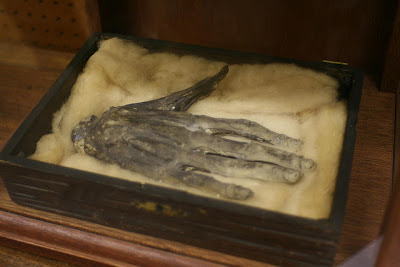
I have a cat named Puppy. When I first met him, he was a very skittish semi-feral cat — too scared to approach anyone. But as my neighbor and I walked around our neighborhood, he followed us up and down the streets — like a little puppy dog, I said. The name stuck.
Puppy obviously wanted to find himself a person, and he picked me. Over the years, he became much more socialized. While he was still primarily an outdoor cat, he'd come inside sometimes and cuddle with me. He hung around the yard a lot, especially as I made it cat-friendly; I even had custom-built cat houses to protect him from the elements.
If you follow me on Twitter, you'll know he wasn't eating well recently — and he just got diagnosed with feline large-cell gastrointestinal lymphoma, a particularly nasty type of kitty cancer. My vet removed the problem area, and it doesn't appear to have metastasized. Today he started chemo — but he's home now, curled up in my bed, eating OK and purring whenever I come and cuddle him. Please send good thoughts his way.
So how do you get organized for such a situation — a suddenly very sick pet? Here are the things that helped me:
1. Instant access to Puppy's medical history.
I scan all my cats' vet records and put them in Dropbox, so I have their history at my fingertips at all times.
2. A wonderful support network.
Besides my vets, who have been superb, I have:
- A fantastic neighbor who I could call to pick Puppy up at the vet when I got stuck in traffic and wasn't sure I'd get home in time.
- A friend who's a great dog trainer and also has lots of animal skills, who came over and helped me coax Puppy out from behind the bed when he was huddled there, out of reach.
- Lots of friends who support me with their kind messages, hugs (both in-person and virtual), little tidbits of practical advice, stories of other pets that did well with chemo, and introductions to other people who might be helpful. And they also just listen when I need to vent. And offer to help however they can.
And then there are all the folks who've posted helpful information on the Internet. I don't know those people, but I sure am grateful to everyone who took the time to share words of wisdom.
3. The right supplies.
Once I had to bring Puppy inside and keep him separate from the other two cats (so he doesn't get scared), I needed things like an extra litter box; I was really glad I already had one on hand. What I didn't have was an array of different foods to tempt Puppy to eat, but that was an easy thing to get.
4. The ability to say no.
Tonight is Halloween, which I usually look forward to; I really like seeing the kids in their costumes. But tonight I put my box of books — the treats I give instead of candy — on the front porch with a note saying I had a sick cat who needed peace and quiet, and to please just take a book or two. It seems to have worked just fine.
And I'm backing out of some evening engagements until things settle down a bit. I know that now, even more than normally, I need to protect my time and focus on the most important things: taking care of my cats; being there for my clients, family and friends; and taking care of myself. (And why is that last one always the hardest thing to do?)






































